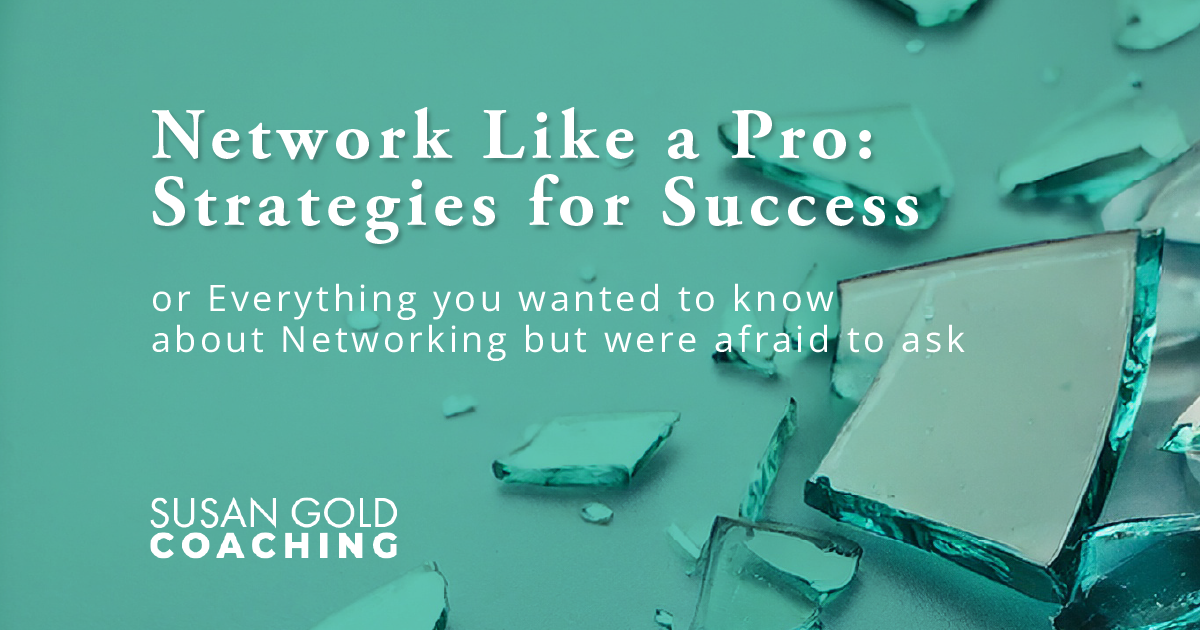Network Like a Pro: Strategies for Success (or Everything you need to know about networking but are afraid to ask)

Networking. I’d rather munch on broken glass.
Not everyone enjoys networking. Some people loathe it. Some feel too shy or too unsure to put themselves “out there” to try and connect with others to grow their business. But love it or hate it, networking is—or can be—an extremely effective way to grow your business, so whichever camp you fall into, networking can make the difference between success and failure.
In the world of professional networking, there’s a stark difference between being busy and being effective. Many professionals find themselves trapped in an endless cycle of events, coffee meetings, and Linkedin™ connections, yet struggle to see concrete results from their efforts. Whether you’re an experienced networker looking to optimize your approach or someone who views networking as a necessary evil, this comprehensive guide will help transform your networking strategy from hopeful activity into measurable results.
1. The Art of Differentiation: Standing Out in a Crowded Market
The fundamental challenge in networking isn’t making connections–it’s being remembered (in a good way!). In a world where the average professional encounters hundreds of introductions from fellow networkers, your ability to stand out determines your success. Yet many professionals suffer the common pitfall of sharing their name, title, company name, and the industry they are in, missing the opportunity to create a memorable impression.
2. Crafting Your Memorable Message
Your introduction serves as your personal billboard, but it needs to do more than just describe your role. The most effective introductions address at least one of three key elements: the specific problem you solve, the measurable impact you create, or your unique value proposition. Focusing on these elements and combining them into a “positioning statement” that becomes your core introduction message is a critical first step to making your networking count.
Time constraints in networking meetings force us to find the fewest words to create introductions that are still memorable, just like a billboard on the highway. For example, my networking “billboard” introduction is “Uncommon marketing strategies that turn into gold.” In just seven words, it communicates both specialty and outcome. Another effective example might be: “Transforming technical experts into trusted business advisors.” These introductions work because they focus on impact, transformation, and results, rather than just services and processes.
When more time is given for introductions, you can apply a more advanced message strategy: The “Problem-Solution-Evidence” Framework. Instead of a standard elevator pitch, structure your introduction as a micro-story:
- Identify a specific, relatable problem your target market faces
- Briefly outline your unique approach to solving it
- Reference a concrete result that proves your effectiveness
For example: “I noticed many technical professionals struggle to communicate their value to non-technical decision-makers. Through our specialized communication framework, we help them transform complex expertise into compelling business value. One of our clients recently secured a $2M contract by shifting their pitch from technical specifications to business outcomes.” See what I did there? In less than 50 words, I told them what problem I solved, how I did it, and the result for a client. When you consistently use this framework focused on Problem-Solution-Evidence, your networking partners will start to remember the problems you solve and the impact you provide.
3. Strategic Targeting: Mastering Intentional Connection
Random networking is expensive networking. The true cost isn’t just the time spent at events but also the cost of connecting with the wrong people while missing real opportunities to connect with the right ones. Advanced networkers understand that success comes from being in the right rooms with the right people and, most importantly, having the right conversations—which leads to the right results (a deal or a referral). How do you determine if you are in the right room? You’ll want to conduct a “network audit.”
4. The Network Audit
Before expanding your network, conduct a thorough audit of your existing connections. This process reveals patterns that can guide your future networking efforts. Analyze your current client base and referral sources to determine:
- Who is providing the right referrals, meaning introductions to Ideal Prospects that become clients who are highly profitable and a great fit?
- Which organizations do the referring connections belong to? Which ones provide the right connections?
- How much activity does it take to get a prospect?
- How are your conversion rates from prospect to client?
This data-driven approach often reveals surprising insights. For instance, you might discover that while general networking groups provide more connections, industry associations enable one-on-one relationship building, often leading to higher-value clients. And before you ask, this works for any size business.
5. Building Your Strategic Network Map
Advanced networkers think in terms of network ecosystems rather than individual connections. Create a visual map of your ideal network that includes the different categories of connections you make. Understanding the types of professionals that also work with your targeted prospects helps create the list of strategic partners that are an important segment of your network. When strategic partners resonate with your solution and it becomes natural for them to refer you, the “networking machine” becomes more efficient. As you identify the types of connections you have, setting up custom fields in your CRM (or whatever system or tool you use to track prospects and customers) helps organize and track connections, as well as finding resources to introduce them to.
Primary Connections:
- Center of Influence professionals
- Direct clients
- Strategic partners
- Industry influencers or experts
6. Triggering Key Introductions: Mastering the Strategic Ask
Successful networkers understand that how you request a connection or introduction is just as important as who you’re requesting. The most effective asks create multiple triggers that result in introductions to that specific person you’ve identified as a target or professionals that are similar.
Strategic asks contain three key elements: a person’s name and company. Secondly, what they do (industry and what they do) and lastly, why you want to be introduced. Any one of these information pieces can trigger exact or like introductions. Your network may not know that exact person, but they’ll likely think of other connections in that industry or other companies that would need your solution.
Consider the traditional approach: “I’m looking for introductions to CEOs in manufacturing.” While clear, this request could be more compelling. A more effective approach might use what we can call the “Strategic Ask” framework:
“I’m looking to meet Jack Jones, CEO of ABX Manufacturing. I’ve noticed many manufacturing CEOs are facing challenges with supply chain digitization right now. We’ve helped several companies significantly reduce their operational costs through our specialized approach. I’d love to connect with Jack Jones or similar manufacturing CEOs who might be facing the same challenges.”
7. Kill the Time Waster: Be in the Right Room
The “rooms” you choose to enter dramatically impact your networking ROI. If you’ve had any experience in networking, it’s common to find yourself in the wrong room. After analyzing members in the room and understanding the quality and relevance of their network, you have to determine if you’re wasting or investing time. Effective room selection is both an art and a science, requiring careful analysis over a reasonable amount of time. Metrics are key, as is a timeline for expected results. Many networking groups will tell you to expect a year to get a referral, which can definitely happen if you don’t have a strategy. Being in the right room, reinforcing your differentiation in your introduction, and making a strategic ask all add up to realizing results much sooner.
8. What NOT to do
All of the above will make you an excellent, differentiated, memorable networker and drive opportunities. But just as there are some important things to do to improve your return on networking, there are also a number of common mistakes we all make that you should be aware of.
- Using industry jargon that obscures your value: it may mean something to you, but if the listener is trying to decode what you’re saying, they will miss the value you bring.
- Focusing on processes instead of outcomes: when someone asks you the time you don’t tell them how to build a watch. When someone asks you to tell them about your work, focus on how you improve things, grow revenue, reduce cost, build client trust, etc. They can always ask you to tell them more, but if you start there, you’ll never get to why your process matters.
- Being too generic in an attempt to appeal to everyone: the urge is strong to avoid excluding potential business. If you are an expert in the B2B world but not in the consumer space, as an example, say so. It’s hard to help someone who “specializes in small, medium-sized, and large businesses in any industry.”
- Changing your message frequently, reducing memorability: there’s always a tendency to be in the same room with people you’ve seen before, so consistency is crucial. Networking is like advertising in that it takes several calls to action before someone responds. Tweaking your story is refinement; changing it up completely is confusing and makes it so much more difficult for networking partners to get their arms around how to help you.
9. The Path Forward: Continuous Optimization
Strategic networking is not a set-it-and-forget-it system. It requires continuous monitoring, adjustment, and optimization. The most successful networkers regularly review their metrics, adjust their strategies, and evolve their approaches based on data-driven insights.
Remember: The goal isn’t to be the busiest networker in the room. You should strive to be the most effective, including the importance of giving referrals. Understanding what others do, the problems they solve and who they serve is the key to unlocking relevant introductions for your networking partners. By implementing these advanced strategies and consistently measuring your results, you can transform your networking from a time-consuming obligation into a predictable driver of business growth.



